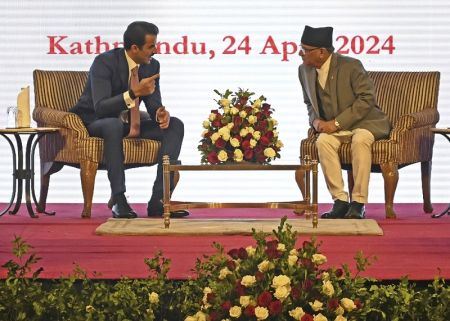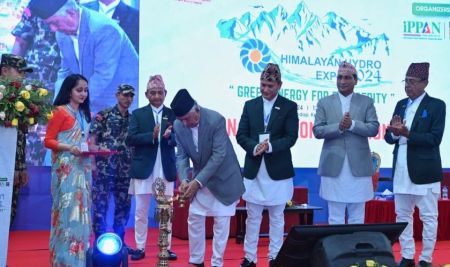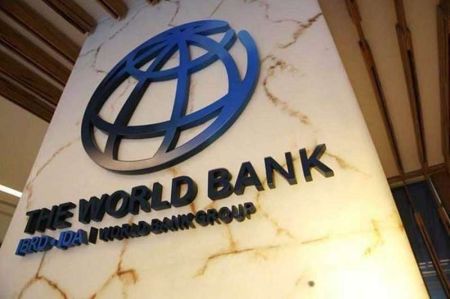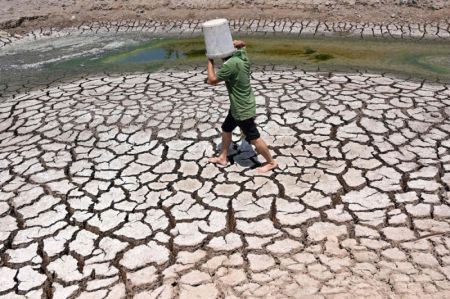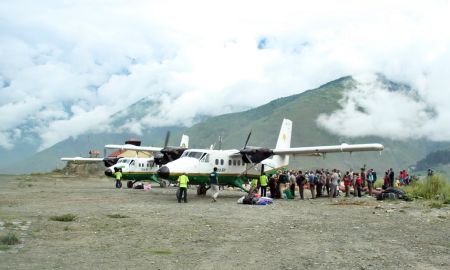.jpg) |
| W.M. Senevirathna Ambassador of Sri Lanka to Nepal |
How is your experience in diplomatic career?
I have come to serve in Nepal, one of the world’s beautiful landmass filled with hospitable and friendly people. Sri Lanka and Nepal both have lot of similarities like culture, religion, food, friendliness and hospitability. I joined government service first as a graduate teacher in 1979 in Vidumina Piriven College, Kandy and joined the Sri Lanka Foreign Service as an Assistant Director at the Ministry of Foreign Affairs, Colombo in 1985. Since then, I have worked in ten Sri Lankan diplomatic missions including West Germany, Pakistan, Malaysia, Lebanon, USA, Canada, and Iraq. I have served as Sri Lankan ambassador to the Philippines, Israel and Nepal.
Apart from this I have worked at the Ministry of External Affairs of Sri Lanka for a short period. I was the Vice Chairman (2006) and Chairman (2007) of the Governing Board of the Colombo Plan Staff College for Technician Education (CPSC) in Manila. I have represented Sri Lanka in various regional and international conferences such as South Asian Association for Regional Conferences [SAARC], World Bank, International Natural Rubber Organization [INRO] and Asian Regional Forum [ARF].
You have been in Nepal for nearly a year now. How are your impressions?
During this time I have met and interacted with Nepal’s senior government officials, politicians, diplomats, and businessmen and exchanged views at various levels. Within this one-year tenure, many high level delegations from Sri Lanka have visited Nepal, especially Lumbini.
Nepal is such a beautiful country filled with lots of historical sites, mountains, and other natural resources. During my stay here, I have travelled to different parts of this country; Pokhara, Lumbini, Chitwan. I have trekked from Nagarkot to Dhulikhel and done rafting in Trishuli and Dolalghat. I have visited Chitlang and had an opportunity to interact with the friendly people of the village. I have also visited historical places such as Bhaktapur, Durbar Square that have masterpieces of skilful architecture, sculptures, and well-preserved ancient monuments that represent the living cultural heritage of Nepal.
How do you evaluate the last elections and where do you see the country heading to next? How will the polls and the outcome affect regional peace and stability and Nepal’s relations with Sri Lanka?
The Constituent Assembly election held on 19th November 2013 was a new step towards the development of the country. The election was conducted in a very peaceful environment and was appreciated by local and foreign observers. Asian Network for Free Elections [ANFREL], Carter Foundations and other observers from different countries took part. The Nepali government had invited SAARC observers to visit and observe the election. Two delegations from the Sri Lankan Election Commission had observed the election. Out of the total 12.1 million population, 9.4 million people casted votes. It is a turnout of 78%, which is very high. As the election was a success, the constitution of Nepal can be finalized.
As a representative of the Sri Lankan Government, we respect Nepali people’s mandate. Political stability will enhance peace and socio economic development of a country. Nepal Stock market Index NEPSE passed 700 points after the election. This reflected investors confidence in the government.
Benefits of the election include inflow of Foreign Direct Investments [FDI] and representation in regional and international conferences, such as hosting the SAARC Summit in the coming year.
Despite signing bilateral trade agreement in 1979, business between the two nations is quite low, less than 2 billion NRs in the last financial year [exports and imports together]. Why still insignificant?
Trade between the two countries has remained at a low level. The Sri Lankan and the Nepali government have taken important steps in the economic and tourist sectors with an aim to increase the volume of bilateral trade, investment and tourism. Various issues have limited bilateral trade between both countries. Limitations include the high cost of transportation and lack of direct air connectivity. These limitations have limited the volume of import and export. Both countries produce and export the same crops and commodities. However, Sri Lanka imports carpets, woollen clothes and lentils from Nepal and exports cocoa, cocoa preparations, table and kitchenware, tea, gem and jewellery to Nepal
What specific measures do you suggest for enhancing the business relations and total value and volume of business between the two nations?
The total value and volume of trade between the two nations is not satisfactory due to the various reasons. Primarily we would like to have direct air connectivity and an exchange of business delegations to attend trade fairs. Recommending each other to attend trade fairs business forums in each other’s capital will help to interact and promote business.
I am pleased to announce that the Chaudhary Group, Nimbus, Youth Entrepreneurs, and Sagarmatha Insurance have already taken steps in this regard. They have visited Sri Lanka and taken part in business forums to extend their business. Similarly, various Sri Lankan companies are taking part in Nepali trade fairs to expand their business here.
Arrival of Sri Lankan tourists to Nepal, especially to Lumbini, has crossed 75,000 a year. What trends and numbers you expect in near future? How can Nepal tourism be promoted in Sri Lanka?
As you are perhaps aware, 70% of the Sri Lankan population is Buddhists. Being Buddhist, they would like to see the birthplace of Prince Siddhartha, “Gautam Buddha” with the excavation at the Mayadevi Temple, Lumbini. Sri Lankan visitors are keen to visit Lumbini, Nepal and want to experience the beauty Nepal offers.
We are in a process to enter into tourism cooperation agreement with the Nepali government so that it will be easy for Sri Lankan tourist to visit Lumbini.
Through tailored tour packages to Lumbini and historical Buddhist places, Nepal can attract Sri Lankan and other nation tourists. More than 5000 Sri Lankan tourist visit to Kathmandu by air and I would like to inform that Sri Lanka Tourist are the number one travellers to Lumbini. If tour packages and facilities are provided, we hope to see the numbers exceed 1000,000.
The Sri Lankan Embassy in Nepal with support of Sri Lanka Tourism Promotion Bureau is arranging a familiarization tour to Sri Lanka for Nepal Tour Operator Association in 2014. I think Nepal should prepare some awareness programme, for example tour packages and other facility to attract Sri Lanka tourists.
What are the initiatives taken by Sri Lanka to upgrade tourism and facilities in Lumbini?
Sri Lanka and Nepal signed the Agreement on Cultural Cooperation in 1999,to expand their cultural relationship further. Sri Lanka has agreed to assist Nepal in heritage management and proposed to establish a course on Culture and Heritage Studies at a university in Nepal.
Support has been extended for Nepali students to study Therawada Buddhismin Sri Lanka. Sri Lanka re-establishment of Therawada Buddhism in Nepal. In 1992 a pilgrims resting place, “Dutugemunu Pilgrim Rest,” was established for in Lumbini for the Sri Lankan devotees. This wasrenovated in 2012 to accommodate over 135 visitors. A bridge close to Lanka Ramaya temple at gate no. 4 of the Maya Devi Temple was constructed to making it easy for visiting the temple. Adding to, the road near the Sri Lankan Temple, which is shortest access to Mayadevi Temple, was widened. The Sri Lankan Government spent SLRS 90 million on all these projects to facilitate Sri Lankan tourists visit to Lumbini.
There has been an air service agreement between the two nations for more than 25 years, which was upgraded recently as well. What is its status and what are the benefits of having fifth freedom rights for Sri Lankan airlines?
Bilateral Air Service Agreement was signed during H.E. the President’s last visit to Nepal in March 2009. Lack of direct air connectivity between the two countries is one of the major barriers in promoting trade.
Code Sharing Basis will facilitate both Sri Lankan and Nepali airlines, to travel to each other’s countries. The fifth freedom right will enable Sri Lankan airlines to get passengers of other destination as well. Sri Lankan government would like to commence air connectivity in the near future and discussions in this regard are being held.
Joint Economic Commission between the two nations was formed a few years earlier. What roadmap and outcome you see of the same in the next two years?
We signed the MOU on Nepal – Sri Lanka Joint Commission in March 2009. Both countries have agreed to hold the first Joint Economic Commission meeting in Sri Lanka. We hope to conduct annual Joint Economic Commissions meet in each other’s capital.
Sri Lanka has a small population, history of civil war, and difficulties in its relations with neighbours, much like Nepal. What suggestions you have for the building of new Nepal, in light of the Sri Lankan nation-building and development experience?
Sri Lanka’s population is 21 million. There was no civil war in Sri Lanka but a terrorist war. Beginning on 23 July 1983, there was an insurgency against the government forces by the Liberation Tigers of Tamil Eelam [LTTE] which fought to create a separate and independent Tamil state called Tamil Eelam . 12% of the population demanded 2/3 of Coastal area and 1/3 of the total Area of the country. Government’s main policy was ‘One Country and One Nation’. After a 30 year military campaign, the Sri Lankan military defeated the Tamil Tigers in May 2009, ending the terrorist war.
For over 30 years, this terrorist war caused significant hardships for the population, environment and the economy of the country. An estimated 40,000 people were killed during the war but Sri Lanka was able to sustain over 6% economic growth rate.
During the conflict period, the Sri Lanka government was able to attract Foreign Direct Investment that prioritized infrastructure development. For nation building, President of Sri Lanka requested all political parties to join hands with the government to overcome national problems. This succeeded in 2009. All political parties supported the government for boosting national economy by forgetting their political differences. As a result, Sri Lanka has positive indicators.
I wish the newly elected member of the Constituent Assembly of Nepal could get together and join hands for the formation of a stable government and serve the people of this beautiful country.







